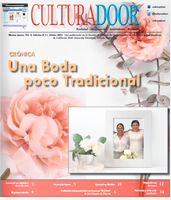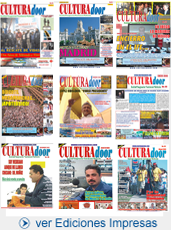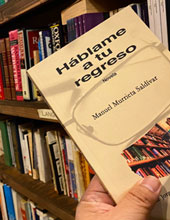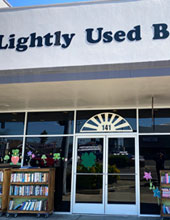|
Día de Publicación:
|
Enviar a:
|
More than five hundred years ago Christopher Columbus sailed the ocean blue in quest of riches and some ineffable notion that the biblical Paradise of the New Testament would suddenly appear in all its splendor. He was an illusionary, some would say a crazed man who needed to defy all the odds in order to satisfy his most basic needs. He wanted fame, he wanted fortune, he wanted eternal salvation.
ENSAYO
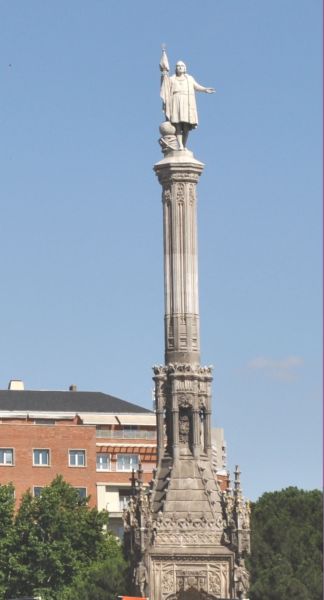
Monumento a Colón en Madrid. Imágenes, archivo de Culturadoor.com
By Dr. Thomas D. Morin
University of Rhode Island
—Culturadoor.com exclusive—
Date of publication: 11- October- 2011
I
In the year of Our Lord and in accordance with the Gregorian Calendar, the year one thousand nine hundred and ninety two, this American continent commemorates the 500th anniversary of the first sighting of this continent by European eyes, of the Discovery of America, as some have said, of the Encounter Between Two Cultures, as others have stated. We commemorate the political and cultural merging between the Old World of the European Continent and the New World of the Indigenous Continent, which today we call America. The year 1992 is a commemorative year of a union forged on the anvil of a struggle between life and death, between love and hate, between Independence and Conquest, between Extinction and Creation. We commemorate the creation of a new cultural syncretism neither European nor Indigenous, but American, that is to say mestizo. More than five hundred years ago an American Phoenix rose up out of the despair and desolation of a vanquished and once proud people and kindled in the hearts of new generations the courage to gaze into the future and construct a new language, new arts, new music, new literature, new customs, new cuisine, new politics, new nations.
Five hundred years ago Christopher Columbus sailed the ocean blue in quest of riches and some ineffable notion that the biblical Paradise of the New Testament would suddenly appear in all its splendor. He was an illusionary, some would say a crazed man who needed to defy all the odds in order to satisfy his most basic needs. He wanted fame, he wanted fortune, he wanted eternal salvation. He convinced himself that God would reveal to him the location of the earthly Garden of Eden. When he sailed to America, he sailed in the name of Spain, a Spain, that had endured seven centuries of military domination by a Moslem African culture. By the time Spain sought to unify its territories under the reign of Queen Isabella and King Ferdinand and the Holy Roman Catholic and Apostolic, the Arabic language had already contributed to the development of some 20% of Spain’s language culture. In 1492, Spain wanted a new identity. King Ferdinand and Queen Isabel gave to Spain a new historical mission: to reconquer the universe in the name of Catholic Spain. Theirs was a sacred mission. Columbus, discovering and exploiting in the name of Spain, was convinced, after his third voyage, that he had discovered in America the Garden of Eden at the delta of what we call the Orinoco River. As we know today, neither Columbus nor Spain ended up in discovering Paradise Lost. Notwithstanding the gold, silver, and other precious stones found in the Americas, Spain’s most prized discovery, in the course of history, was that she would assist in giving birth to a new cultural heritage , the cultural heritage of Latin American mestizo civilization.
Recently, the notion of some metaphorical Antichrist arriving and conquering the earth has gained ascendancy in certain academic circles. This evil that stalked the internal world of medieval man’s mind, has been transformed into the image of Western Civilization and its imperial conquests. Within the schematic view of this historical interpretation, the first Antichrist is Christopher Columbus, responsible for the slaughter of hundreds of thousands of the New World’s indigenous population. Columbus, in accordance with this perspective, ought to be judged as a violator of human rights, a figure of demonic proportions. Such historical revisionism holds Columbus to be the harbinger of Western European greed, capitalist exploitation, slavery, and genocide. Recently, in Minneapolis, a mock trail was held and Christopher Columbus was found guilty of all kinds of crimes against humanity.
No one would deny the historical tragedy of the effects of the Conquest of America on indigenous populations and their cultures. Europeans were mesmerized by their discovery of new lands which held the promise of great wealth. Christopher Columbus seemed to prove to them that they could become the masters of the earth, that they could control man’s destiny. The Discovery of the Americas made them feel like gods. For the European the Discovery was breathtaking. Combining religious doctrine with the political notions of empire building, they crossed the seas to lay claim to what they conceived as part of a divine plan and, in doing so, they waged Holy War on the unsuspecting indigenous populations they discovered. Their mission was stated in Aristotelian terms, convert barbarism to civilization. Bit by bit the military skills of the adventurous Spaniards and others overcame the indigenous resistance to the Conquest. Beaten into submission by a combination of military tactics and weapons never before seen, new diseases, the relatively successful proselytization by Roman Catholic friars belonging to different confraternities, combined with an all consuming belief in the fatalistic prognostications of their own religious out-look, the indigenous populations soon lost their desire and their ability to maintain their cultural identity.
In 1992, we commemorate the most noble aspects of Spanish society and the rich heritage of America’s indigenous past. Symbolically, as can be seen throughout Mexico, Spain constructed Christian chapels and churches atop the broken temples of indigenous cultures, defeated in warfare. Spanish saints stepped into the burning embers of the dying Aztec, Inca, Maya-Quiche, Guarani, Chibcha gods, and were transformed into new representations of spiritual existence. Spain, either because of its experience in dealing with multicultural phenomena, or due to its intellectual wisdom assisted in developing the new hybrid cultures which form the variant strains of what we call Hispanic American culture and identity, for what we call Hispanism is in reality a multifaceted admixture of different and even dissimilar cultural codes. It would, therefore, be a mere exercise in academic shortsightedness and intolerance to write off the Conquest as something which should never have taken place, and Christopher Columbus as a personae non-grata in the Americas. No reading of History can legitimately declare null and void the positive contributions to human society which rose from the utter devastation of Americas once glorious indigenous past. Furthermore, to declare in this age of cultural relativism and political correctness that the only legacy of Western European domination of the Americas has been a history of the abject subjugation of indigenous peoples, and the exploitation of the land, disingenuously fails to recognize the universal dimension of Conquest as a tragic but endemic historical problem that has plagued human existence since the beginning of time. Furthermore, the mythical view of Western civilization as the evil which has wrecked havoc on the world juxtaposes a kind of innocent Rouseauonian view of the Americas prior to Hispanic domination, as a land of political harmony and economic egalitarianism. Nothing could be further from the truth. Even Rousseau saw fit to change his mind before becoming a part of History.
The academy cannot permit Hispanic culture to become the white Antichrist in this mannequin view of history. The Black Legend was and still continues to be a political and partisan interpretation of events. Yet, in spite of the tragedy, man’s creative abilities did not perish nor languish for long in the Americas. Between 1492 and 1992, new generations of mestizos were born. Cities were built, universities were organized, new national identities began to manifest their desire to determine the course of their own history. In the Americas between 1492 and 1992 books have been written, songs have been composed, riches have been discovered. If our historical vision were to remain rooted in the inequities of the moment of Conquest, how would we be able to evaluate all that has transpired in the Americas during the last 500 years.
We all would like to vanquish the evil that stalks this precious earth, to strip the darkness from man’s heart. History, which in the end cannot be interpreted from a very scientific point of view, constantly puts us in a quandary politically and intellectually speaking. Like the forces of nature, history unfolds with its ongoing process of death and renewal. In this sense, the historical process is neither moral nor immoral. After the historical marriage has been consummated, the mechanism for developing a new family with its own heritage cannot be reversed. We do not have at our disposal the means to absolve nor condemn History. We may deplore the practice of certain institutions within an historical framework, we may abhor the personality and brutality of certain historical figures, but we cannot judge with any clear sense of right or wrong an historical process which over time forges the development of nations and national identities, else we be caught in the unenviable intellectual position of denying the validity of the present. Furthermore, in order to maintain the logical consistency of such an argument for the Americas, the very language which today is used to discredit the Conquest and Colonization would have to be used to discredit the very Aztec civilization which Hernan Cortes conquered in 1521. The indigenous advancement that discovered the valley of Mexico for the benefit of the chieftains of the Messica civilization did not play a very different role in the military conquest of the Valley than did Columbus in the Spanish Conquest of the Americas.
II
Hispanic American civilization today is the result of a new cultural syntheses , as we have already stated, created from the emotional and psychological substance of burned out civilizations which did not have the technological nor the intellectual acumen to defend themselves against the use of steel and powder, horses, and the cross. The mightiest of these pre-Hispanic civilizations the Aztec, the Araucanians, and the Incas fought bravely. Fortunately, the record of their struggle and suffering was documented somewhat. Today, that historical evidence and the literature which it spawned remains part of Hispanic America’s cultural legacy, a tragic legacy which, at the same time, breathed life into new forms. If the historical record of Columbus is to be censored so severely that the least said about him the better for History, then what ought the inhabitants of Hispanic American countries to feel and say about the cultural heritage which stems from this moment of Conquest? Are the critics of Columbus saying that Mexicans and Chileans and Peruvians ought to display in this 500th anniversary a collective sense of remorse and guilt for the unpleasantries wrought by History many centuries ago? If Christopher Columbus is to be tried and convicted for genocide and other war crimes, then, does it not follow, that when Latin Americans pay tribute to Cervantes, the intellectual mentor of all Latin Americans writers, that they are, in fact, paying homage to the very civilization which perpetrated the crimes for which Christopher Columbus is condemned? Should Latin American writers renounce their participation and membership in the Royal Spanish Academy of the Language ? Of course, my response is a resounding no
The interpretation of History is an exercise in poetry made necessary by mankind’s constant attempt to justify and give reason to his existence. The individuals that make up that History in the context of that epic become representational figures, allegories representing a certain meaning vent to the narrated events. These figures become in History what in life they were not. In life, they had no idea they would eventually serve as catalysts for the creation of Historical meanings. Though he did not know it at the time, Christopher Columbus’s voyages changed the History of the World not only for the indigenous populations of America, but for Western Oriental Civilizations as well.
The Conquest of the New World by the Old, as we look back in time, also represents the Conquest of the Old World by the New. With the intrusion of New World realities into Old World concepts, the intellectual climate of that Old World changed drastically. Aristotelian Scholasticism had to be jettisoned for a more relativistic and empirical approach to understanding the human condition. New physical and social sciences emerged from that period of Conquest.
As part of the epic interpretation of Hispanic American culture and society, Cristobal Colon is the herald who brought a new language to the Americas. Through that language, there was to be established a new cultural identity that would neither be completely Spanish nor completely indigenous American. In the epic interpretation of Hispanic American culture, the historical Columbus cannot be recognized as the symbol of tyranny nor genocide. To do so, would deprive the Hispanic American of the value of his Hispanic identity and cultural values belong to him, the roots of which and to be discovered in Spain’s art, literature, and philosophy.
Latin America is a baroque society that has forged its identity in the struggle between opposing cultural values. Such is the nature of its mestizo heritage. From a psychological and esthetic point of view, the past 500 years in Latin America has been a struggle to seek a reconciliation between the arrogance of Conquest and the struggle to survive. In a poem entitled “Ballad of the Two Grandfathers,” Nicolas Guillen expresses what is very clear and poignant: that this struggle for historical reconciliation is the newness of America. Painfully, the beleaguered pre-Hispanic nations of the hemisphere succumbed to Spanish rule and religion. Within a brief period of time, Spanish, also, became the language of multitudes of African blacks forced into slavery. By the middle of the 17th century, black men were entering into monasteries having shed much of their African animistic heritage. One of these men even became a Catholic Saint, San Martin de Porras.
Spanish is spoken in some 18 countries in Spanish America and by some 300,000,000 inhabitants. It is the language of national identity notwithstanding the continued limited use of Nahuatl in Mexico, along with several other indigenous languages, Maya-Quiche in Guatemala, Quechua in the Andean region, Guarani in Paraguay. In some countries, indigenous populations are still very strong and economically important. However, even these people are mostly bilingual and their costumes have become only faint images of their ancient past. If we must identify Latin America with a single phrase, we soon realize that Hispanic America, as is the United States, is a mestizo culture. It has become a cultural syncretism of many cultural and linguistic currents.
III
Beginning with Florida in the East to California in the west, Montana in the North and Arizona in the South, Spanish has left an historical legacy within the geopolitical confines of the United States since the accidental voyages of Alvar Nuñez Cabeza de Vaca in the 16th Century. Florida is the land of flowers, possibly named after the celebration of Easter in the Spanish language. Las Vegas, the gambling capital of the United States, is a Spanish phrase meaning the “Plains or Palteau” regions. Montana is the lands of mountains; Arizona is the arid lands. California refers to a land of milk and honey, utopia, a place identified in the Spanish books of chivalry of the 15th Century. The original Spanish explorers who landed in that region were overcome by its natural beauty. California was a magical name. It conjured up images of a world hune by man’s imagination.
After the period known as the Conquest, from Florida to California, missionaries and other people of adventurous spirit were given land grant rights to settle and develop the land: sheepherders, cattlemen, farmers. Even today, in both Louisiana and other Southwestern states, there are families who can trace their heritage back to these early settlers. In an historical sense, these Hispanics owe their cultural allegiance not to Mexico nor to the Dominican Republic, nor to contemporary Spain, but to a Spanish colonial tradition long disappeared. The ancestors of these people never really became part of what in the nineteenth century became Mexico. For the most part, they lived as pioneering families who helped in developing the cattle and farming industries of the West.
It was once contemplated in Washington, in the 19th century, to make Spanish an official language of the United States along with English. Certain founding fathers were well aware of the existence of a long Spanish heritage in the South and Southwest.
At present, the so-called Hispanic population of the United States, in accordance with U.S. census criteria, constitutes approximately 10% of the population. Today, these immigrants, and their descendants, can trace their Hispanic heritage to all the countries in the hemisphere, which gained their Independence from Spain in the nineteenth century. Many of these countries did not become real nation states till the end of the century. Two of these countries are Puerto Rico and Cuba, which did not become independent till 1898, with the help of the United States.
While many people today seem surprised at the increasing number of Hispanics who come to live in New York, it was really at the end of the nineteenth century prior to their Independence that both the Cuban and Puerto Rican Communities began to find a home in the city. At that time, New York became a gathering place for intellectuals and politically conscious workers who began to organize on behalf of the struggle for Independence. Most of these intellectuals, such as the famous writer Jose Marti, found jobs as tobacco rollers, waiters, or newspaper men. They succeeded in building grass root movements designed to foment revolution against Spanish rule in their respective countries. In part, the result of their efforts was the War of 1898, known as the Spanish-American War.
In the meantime, the South West of the United States during the latter part of the nineteen century saw a constant coming and going of Mexicans seeking to enrich themselves in the hunt for gold and to participate in the cattle industry of frontier America. Mexicans, it has been said, were the best cowboys. During the Mexican Revolution of 1910, many Mexicans sought refuge from the fighting in the frontier towns of border states. Sometimes these states even acted as temporary refuge for guerilla fighter when things got too hot in Mexico. The identification of the fleeing Mexican as the “wet back” or the “espalda mojada” dates from the Mexican Revolution to the present.
IV
By the early 1960’s, because of economic instability and political chaos in many Latin American countries, the U.S. began to experience a huge influx of illegal and legal immigrants from Hispanic America. Along with the traditional Mexican migrant worker, other groups in large numbers began, and are still, seeking political refuge and economic relief from institutional situations in their countries that have rendered life very difficult, if not impossible. As most of us know, Salvadorans, Guatemalans, Colombians, Argentineans, Uruguayans, Nicaraguans, Chileans, Dominicans, Cubans have all developed small communities in many parts of the U.S. In practically every state in the Union, Hispanic communities have sprung up. Similar to the behavior of other ethnic groups in the U.S. , these groups have developed markets for their food and music, and literature. In all major urban centers of the U.S. one can find newspapers which cater to one or all groups and radio and T.V. programs which seek to promote a sense of community, Hispanic community, based on the use of Spanish language, the thread that attempts to hold this community together.
Notwithstanding official governmental figures which seek to identify the Hispanic population in the U.S., the so-called references in the press that have been made regarding the Hispanic vote, and the identification on University campuses of “Hispanic” organizations, Hispanic identity in the U.S. is not easily definable. The idea in the Anglo speaking community that that Hispanics in the U.S. form a particular ethnic group bound together by a common heritage and cultural norms is more the result of cultural stereotyping and an inability on the part of the Anglo community to differentiate between cultural and political differences within said community.
In the Organization of American States, for example, as occurs in the United Nations, ambassadors argue their positions in terms of their particular national interest. Decisions are not made in terms of some collegial sense of being part of Hispanic culture and society. Latin American History bears this out in many, many ways, since Independence from Spain. Border disputes which have culminated in long and nasty wars are part of Latin America’s historical reality. Intellectuals may advocate a sense of “Hispanism”, but, for the man on the street such a concept has virtually nothing to do with reality and the way in which he-she expresses their cultural identity. National and cultural pride comes from being Mexican, Venezuelan, Colombian, Argentine, etc., not from some ephemeral notion of being Hispanic. Nationalism in Latin America is extremely xenophobic. The elements which make up this identity consists of: food, music, dance, song, history, language, family, religion, literature, and the idiosyncrasies of daily life which identify, in a particular country, how things are done. Not all Latin Americans identify with salsa music or merengue. Not all feel that their national identity includes indigenous groups such as the Incas or the Aztecs. What they all do have in common is an identity with Miguel de Cervantes, the greatest Spanish writer of all times and one of the world’s greatest literary luminaries. In the various areas of Latin America, these cultural elements are very different. Chileans or Mexicans who come to the United States do not see themselves as Hispanics coming to the U.S. but as Chileans or Mexicans. In a similar way, Mexicans visiting Argentina visit as foreigners and, for the most part, they react as foreigners with one advantage, the similarity of language spoken by Argentines and Mexicans. The notion of fraternal or cultural Hispanism has as much appeal as Afro-Americanism has for Jamaicans, or Europeanism would have for French immigrants. New York or Providence can be used as classic examples of what I am talking about. In both cities there exist fraternal organizations for immigrants from the Dominican Republic, Puerto Rico, Colombia. These organizations, in general, establish themselves as points of contact for people who identify with their particular cultural expression. Social events which highlight Dominican or Puerto Rican Independence or other holidays are geared to appeal to that particular segment of the Hispanic population, almost exclusively. Furthermore, many times these cultural organizations spring up to satisfy the needs of a particular segment of the Puerto Rican community, for example immigrants from Mayaguez, or Colombians from Barranquilla or Medellin.
Politically, the Hispanic population of the United States does not represent any identifiable unity. For the most part they are satisfied with the status quo since for most of them economic opportunities in this country are greater then they would have had in their countries. Even if they continue to struggle to survive, they are grateful for the political order which the U.S. represents to them when contrasted to the political disarray apparent in many of the Latin American political systems. Furthermore, these immigrants are, for the most part, untrusting of public servants and political figures. At the same time, their political ambitions when they do become manifest are very different. Puerto Ricans since the beginning of this century have been obsessed with the political identity of their island. Three different groups advocate the virtues of their commonwealth status, of statehood , and independence, even though independence is in reality desired by only 3 per cent of the population, most of whom are university students. With Mexican Americans there exists a different set of priorities. Most are concerned with the U.S. establishing a positive relationship with Mexico and with earning enough money to assist their relatives in said country. On a per annum basis, Mexicans return to Mexico several millions of dollars which helps out Mexico in maintaining a certain amount of dollars in their federal reserve, which in turn assists in stabilizing the value of the Mexican peso. Cuban Americans have had during the last thirty years a different set of priorities: the desire to see their island liberated from a neo-Marxist dictatorship. Salvadorans, Guatemalans, and Nicaraguans have come to the U.S. seeking a haven from the civil unrest in their respective countries. Colombians have come to the U.S. for two reasons: to escape the political unrest besetting their country and to improve their economic situation. most Dominicans are in the U.S. because of the high unemployment levels in the Dominican Republic. For all of these new comers the reference point for their particular problem in their respective countries has nothing to do with being Hispanic in the U.S. Almost all of these pilgrims to the U.S. believe that the U.S. can somehow deliver them from their hardships. Contrary to what many academics would like to believe in the United States the U.S. has an excellent image among the poor and the middle class in Latin America: a place where hard work pays off, where people are healthier, where it is easier to enjoy the comforts of life, where inflation is extremely low, where politics makes sense.
In the U.S., those who are apt to identify themselves as Hispanic- American are either second or third generation sons and daughters of immigrants, or those who came to the United States quite young with little recollection of life in their native countries. In reality, these individuals have become acclimated to the American way of life and their real cultural identity is measured through their use of the English language and their adaptation to the American way of doing things. more often than not, should these students return to their countries of origin, they discover that they are different and, sometimes, feel more ill at ease than U.S. students who travel to these countries without any prior experience with the culture. Tato Laveira is a Puerto Rican American poet who grew up in N.Y., which he identifies as his city. He writes in Spanish and in English. His cultural image is that of an AmeRican. (poems “english”, 23; “Spanish””, 33; “AmeRican”, 94).
The answer to the question, Why Columbus?: Because of all that you have seen and heard from this text. In the year 1492 of our Lord, Columbus sailed to unknown places; in 1992, in the year of this same Lord, we remember the odyssey, and the amazing baroque configuration of that journey, with all its horror and joy…
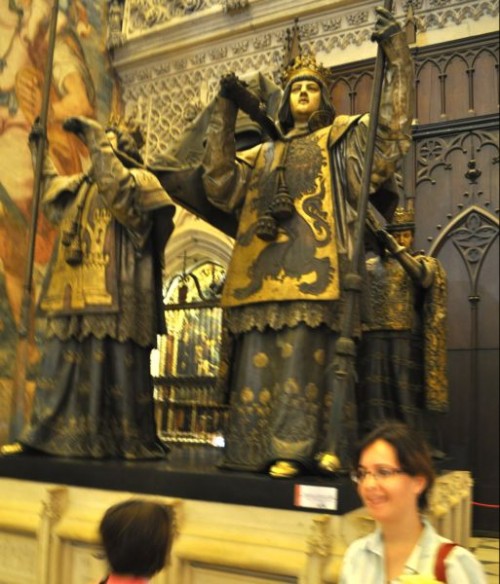
Mausoleo a Colón en Sevilla, España











